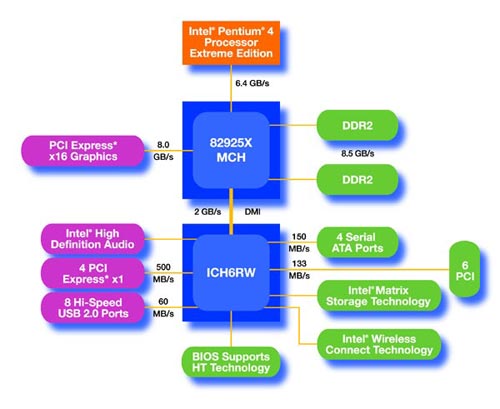Socket T Arrives & Comes With A Plethora Of Goodie
The Chipset(s):
Today we have three new chipsets:
- 925x – Intended to be an ultra-high end solution; replacement for the 875P chipset. Supports DDR2 only.
- 915P – The ‘high end mainstream’ solution; replacement for the 865PE chipset. Allows motherboard makers to choose DDR2, DDR1 or both.
- 915G – Same as above, but includes a DX9-capable integrated graphics controller. (1500points on 3dMark2003 when we tested it)
Here is a diagram of the new i925x Chipset:
PCI-Express
The x16 graphics card slot is the one of the main highlights of the new chipsets and is supposed to be the replacement for the current AGP interface. The new PCI-Express slot can handle 8 GB/s of traffic compared that to the 4GB/s AGP 8x is capable of. This gives the graphics card almost direct access to the system memory and also incorporates bi-directional data transfer. Think streaming High Def video and gaming here people!!
The four x1 PCI-E slots, or “one lane” slots, get 250MB/s of bandwidth in each direction. This makes for an effective 500MB/s of bandwidth for quick data transfer for new audio devices and other add in cards. This too is a massive improvement as a current PCI slot moves 75MB/s of data across the data bus. While we haven’t used anything on these yet, I’m sure in the near future we will start seeing everything from NIC cards, audio cards, RAID controllers all be re-designed for the new x1 PCI-E bus.
Storage Technology
Intel’s new SATA controller on the ICH6 is a step forward from what was available on ICH5. Intel has actually introduced a few new storage technologies with the 9xx chipsets! First and foremost is Matrix Storage Technology, which basically allows you to use RAID 1 and RAID 0 on a single pair of drives and the other new technology is Native Command Queuing (NCQ). NCQ is one of the first advantages we are seeing from native SATA hard drives (as opposed to bridged solutions, which is what everything is right now). What NCQ does is allow the drive to ‘decide’ whether to execute commands, or queue them for later, depending on the current state of the drive (where the heads are, etc). This is pretty neat technology and we expect that NCQ will become mainstream across all storage controllers. While we have not had time to check out this new technologt we were shown this whitepaper from Seagate and Intel and it explains it in more detail for the time being.
DDR2
If you’ve been to Legit Reviews before you know we pride ourselves in our memory reviews. Expect complete coverage of DDR2 in a seperate article in the upcoming week. We’ve been able to hit DDR2 667 and will tell you our thoughts on DDR2. Right now DDR2 533MHz is the staple memory and comes at 4-4-4-12 CAS Latencies. Expect lower timings in the upcoming weeks as new IC’s are hitting the market and companies like Corsair are already adapting these new IC’s!
Hi Definition Audio
Finally I am seeing the death of the AC97 codecs! This was a weak point on every motherboard that we have come across recently, but this is no longer the case! Now we are going to be able to have 192kHz, 24 bit, 8 channel audio from an on-board solution! This is great news for everyone, but the add in card partners such as Creative. The new High Definition Audio also supports Dobly Digital EX and DTS ES. Indeed this is the biggest jump for integrated audio in 5+ years!
Wi-Fi
Although not available to us just yet & it’s disabled in our grantsdale review board, Intel will have a version of their southbridge with integrated Wi-Fi (802.11g). 802.11g is capable of 54Mbps, and is fully backwards compatible with the well-rooted 802.11b. The only concern is that it has quite a lower range.
Individual Test Systems:
- Intel P4 3.4 “C”, Intel P4 3.4″E”– ABIT IC7-MAX3 (Intel 875P), 1GB (2x512MB) Kingston PC3500 HyperX @ DDR400 (2-3-2-5), ATI 9600 XT 128mb (Catalyst 4.6), 120GB Seagate SATA150 HDD, Windows XP w/SP1 and DX9B.
- AMD Athlon 64 3800+ — ASUS A8V (VIA K8T800 Pro w/ Hyperion Drivers), 1GB (2x512MB) Kingston PC3500 HyperX @ DDR400 (2-3-2-5), ATI 9600 XT 128mb (Catalyst 4.6), 120GB Seagate SATA150 HDD, Windows XP w/SP1 and DX9B.
- Intel P4 560 — Intel Intel D925XCV (Intel 925X), 1GB (2x512MB) Crucial PC4200 @ DDR2 533 (4-4-4-12), ATI X600 XT 128mb (Catalyst 4.6), 120GB Seagate SATA150 HDD, Windows XP w/SP1 and DX9B.
Testing Procedure :
All testing was done on a fresh install of Windows XP Professional build 2600 with Service Pack 1A and DirectX 9.0b. All benchmarks were completed on the desktop with no other software programs running. No overclocking was done on the video card durning any of this review. We did disable the Firewire, and LAN features if found in the BIOS menu for all the testing completed during this review.
To keep the testing as fair as possible we used an ATI 9600 XT and an ATI X600 XT both clocked at the same speeds. For this we had to overclock out memory on the 9600 XT, but this should allow for pretty equal video card performance since both are running the same core design at identical memory and core speeds. Both cards had the core clocked at 500MHz and a memory clock of 740MHz. This should yield an equal 2.2GB/sec of memory bandwidth for both of the cards and allow some “equal” benchmarking for gaming performance.
Now for the results!


Comments are closed.